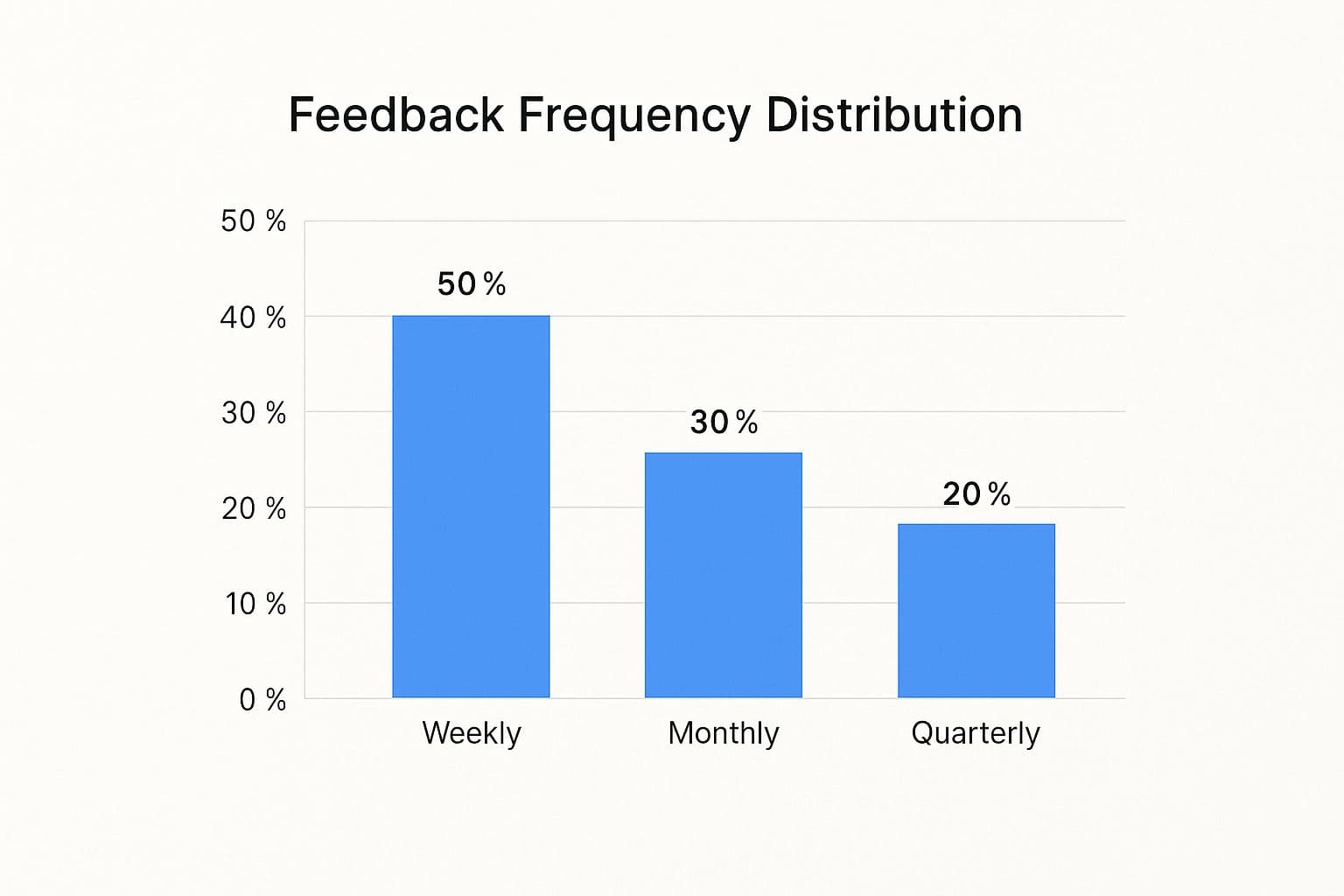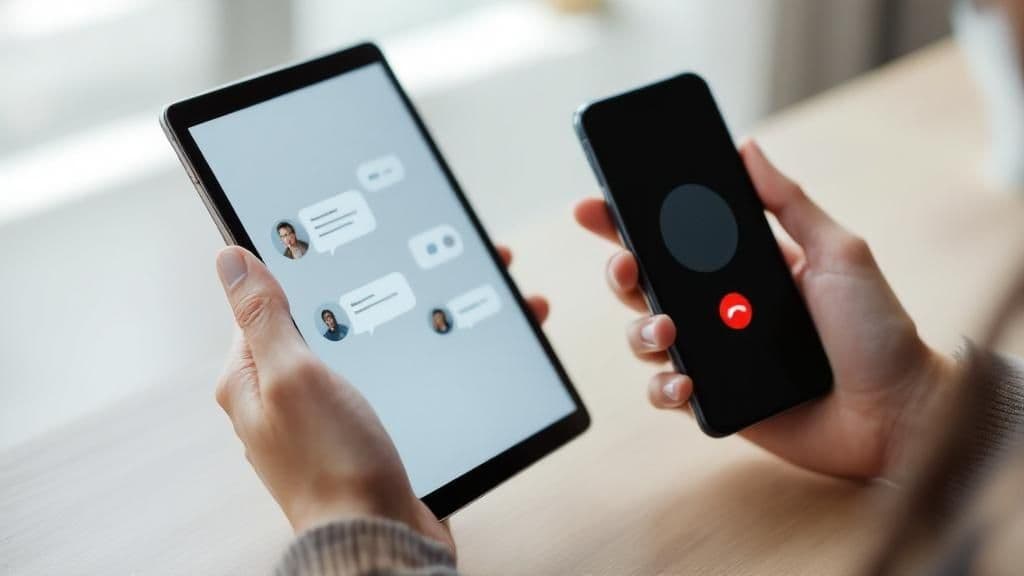Improve Workplace Communication The Modern Guide
Learn how to improve workplace communication with actionable strategies for trust, clarity, and collaboration. Boost team productivity and engagement today.

We’ve all been there. You're sitting in a meeting that definitely should have been an email, or you're watching a project slowly go off the rails because of a tiny misunderstanding. It’s frustrating. The secret to fixing this isn't some complex formula; it's about treating communication as a deliberate practice, not just something that happens.
To really improve workplace communication, you have to focus on the fundamentals: building trust, making sure your messages are crystal clear, and picking the right tool for the conversation.
Why Great Workplace Communication Is Non-Negotiable

Let's be honest, poor communication is more than a small headache. It's a silent killer of productivity, morale, and momentum. It’s the missed deadline because no one was sure who owned the task. It’s the brilliant idea that dies on the vine because someone didn't feel comfortable speaking up. This isn't just a "soft skill"—it's a hard business strategy.
When a team clicks and communication flows, the results are tangible. I've seen it myself. Teams that are genuinely connected can see their productivity jump by as much as 25%. It's no wonder that a whopping 97% of workers believe the quality of communication directly affects their tasks every single day.
Before we jump into the solutions, let's take a quick look at the stark difference between good and bad communication. It really puts the stakes into perspective.
The Real Impact of Workplace Communication
| Business Area | Impact of Effective Communication | Impact of Ineffective Communication |
|---|---|---|
| Productivity | Projects move smoothly with clear roles and goals. | Constant delays, rework, and wasted time. |
| Employee Morale | Team members feel valued, trusted, and engaged. | Frustration, burnout, and high turnover. |
| Innovation | Ideas are shared openly; constructive feedback is welcome. | Fear of speaking up stifles creativity. |
| Conflict | Issues are resolved quickly and constructively. | Small misunderstandings escalate into major disputes. |
| Profitability | Efficiency increases, and resources are used wisely. | Costs rise due to mistakes and lost opportunities. |
See the pattern? Ineffective communication isn't a single event; it's a series of small frictions that grind a team down.
The Real Cost of Miscommunication
Think back to the last time a project truly went sideways. I'd bet good money a communication breakdown was the root cause. These aren't isolated incidents; they create a ripple effect that touches everything.
- Sinking Morale: When people are constantly confused or have to redo their work, they feel drained and unappreciated. It's a fast track to disengagement.
- Wasted Hours: How much time is lost trying to clarify confusing instructions or sitting in meetings that achieve nothing? It adds up.
- Innovation Gets Stifled: If people don’t feel psychologically safe, they won't share that "crazy" idea that might just be the next big thing. Valuable feedback gets buried.
- Friction and Conflict: It’s so easy for a simple "I thought you meant..." to spiral into personal conflict, poisoning team dynamics and creating a tense environment.
The bottom line is that great communication creates clarity and trust. It’s the essential lubricant that keeps the gears of a team turning smoothly, while poor communication is the friction that grinds everything to a halt.
If you're looking for more frameworks and ideas, exploring these actionable strategies for improving team communication is a great next step.
Ultimately, taking the time to improve how your team talks isn't just about avoiding problems. It's about unlocking the creative and efficient powerhouse you know your team can be.
Build Your Foundation of Psychological Safety
Before you can even think about improving communication, you need to build a culture where honest conversations can actually happen. All the best communication tricks in the world will fall flat if your team is walking on eggshells. This all comes down to psychological safety—that feeling everyone on the team has that they can speak up, float a wild idea, or even admit a mistake without getting shut down or humiliated.
This isn't just a feel-good buzzword. It's about getting down to business. When people feel safe, they stop wasting mental energy on protecting themselves and start pouring it into creative solutions and real teamwork. Think about it: research shows that a huge number of project failures come from conflicts that just simmer under the surface. In fact, 23% of employees have actually quit a job because of it. That’s a real, tangible cost of a low-trust workplace.
Psychological safety isn't about everyone being nice all the time. It’s about creating an environment where people can be candid, and where a healthy debate is seen as a good thing, not a sign of trouble.
Champion Transparency from the Top
It all starts with leadership. When leaders are open about their own struggles, admit they don’t have all the answers, and share information instead of hoarding it, they set the tone for everyone else. This isn’t about TMI; it's about being a real, relatable human.
For instance, a manager could kick off a meeting by saying, “Honestly, I’m still figuring out the best way to tackle this new campaign. I really need to hear your unfiltered thoughts and worries.” That one sentence immediately invites real talk and signals that it’s okay to be vulnerable.
This kind of transparency trickles down, making it natural for everyone to communicate more openly. If you want to dig deeper, there are great resources on the benefits of psychological safety at work.
Practice Genuine Active Listening
Let's be real—most of us listen while just waiting for our turn to speak. Active listening is different. It’s about making the other person feel genuinely heard. That means giving them your full attention, parking your judgments, and actually reflecting back what you heard to make sure you got it right.
Picture this: A junior designer mentions they're nervous about a project timeline.
- A passive response might be: "Don't worry, we'll figure it out." This completely dismisses their concern.
- An active response sounds more like: "It sounds like you have some concerns about the deadline. Can you walk me through what's on your mind?" This opens the door for a real conversation.
This small shift doesn't just get you better information; it validates your team member's input and reinforces that their voice matters. It’s funny, but learning to communicate clearly with people is a lot like learning to communicate with AI. You have to be incredibly clear about your intent. If you're curious about that parallel, you can see how it works with these system user assistant prompts explained.
Encourage Constructive Feedback Loops
Finally, you build and maintain psychological safety by making feedback a normal, healthy part of the routine. The goal is to create regular opportunities for people to share their thoughts without it feeling like a personal attack.
Here are a few practical ways to make this happen:
- Regular One-on-Ones: Make it a point to ask, "What feedback do you have for me?" in every single one-on-one, and be ready to listen without getting defensive.
- Project Retrospectives: After a project wraps, hold a blameless post-mortem focused only on what went well and what could be done better next time.
- Peer Feedback Sessions: Set up facilitated, low-pressure sessions where team members can give each other constructive praise and helpful suggestions.
When feedback just becomes part of how you work, it stops being scary. It shifts from something that causes anxiety to a powerful tool that helps everyone grow.
Getting Straight to the Point: Mastering Clear Communication

Let's be honest: being clear is about more than just using simple words. It’s a sign of respect for your team's time. When you send vague requests or rambling emails, you're creating friction and forcing people to play detective just to figure out what you want. Every single message—from a quick chat to a formal memo—should have a crystal-clear purpose.
This isn't just a "nice-to-have." As of 2025, communication is still the number one skill employers are looking for, with 57% of them highlighting its importance. It makes sense, especially when you hear that a staggering 86% of employees and executives point to bad communication as the root cause of most workplace failures. You can dig into the numbers yourself in the full communication statistics report on pumble.com.
Picking the Right Tool for the Job
A huge part of communicating with purpose is knowing where to say something. Firing off a novel-length question in a fast-paced chat app is a recipe for disaster. So is calling a 30-minute meeting for a one-sentence update. It’s all about matching the message to the medium.
Before you hit "send" or schedule that meeting, take a second to think: what’s the best way to get this message across without causing a ton of disruption?
- Slack or Teams: These are your go-tos for quick questions, snappy updates, and casual check-ins. Think of it for things that need a fast, but not necessarily immediate, reply.
- Email: This is better for more formal stuff—think official announcements, detailed project updates with attachments, or anything you need a paper trail for.
- A Quick Call: Is a chat thread getting out of hand? If you've gone back and forth more than three times, just pick up the phone. It's perfect for sorting out complex issues that would take ten emails to explain.
- A Formal Meeting: Save these for the big stuff. We're talking strategic discussions, team brainstorming, and big decisions that need everyone's focused attention and input.
The real goal isn't just to broadcast information. It's to make sure your message is actually received and understood with as little effort as possible on the other end. Choosing the right channel is your first, and most important, step.
Ditch the Jargon and Write Like a Human
Nothing makes a message more confusing than loading it up with corporate buzzwords and acronyms. It creates a weird insider/outsider vibe and forces people to either guess what you mean or feel silly for asking. Just use plain English.
So instead of saying something like, "We need to leverage our synergies to action a paradigm shift," just say, "Let's work together on a new approach for this project." See? Clear, direct, and way less cringey. This is a skill you can build over time. If you want to polish your writing, our guide on how to write professionally has some great tips.
A great little mental checklist for any message is the classic "5 Ws":
- Who is this for?
- What do they absolutely need to know?
- When is it due or happening?
- Where can they find the details (like a link or document)?
- Why should they care?
Running your messages through this simple filter before you send them can save you from the endless back-and-forth that absolutely tanks productivity and team morale.
Choosing the Right Tools for Your Team
In today's world of remote and hybrid work, your digital toolkit is basically your new office. Having the right tech is a huge part of great workplace communication, but just throwing more apps at your team isn't the solution. The real goal is to build a smart, intentional communication stack that makes work easier, not just louder. Piling on too many platforms just leads to confusion and burnout.
The secret sauce is purpose. Before you fire off a message, take a second to ask yourself: what’s the best way to send this for maximum clarity and minimal disruption? This simple habit prevents that classic mistake we've all seen—a complex project issue getting dropped into a real-time chat, when it really needed a focused, face-to-face conversation.
The massive shift to remote work has completely changed how we all connect. The pandemic pushed 74% of businesses to start using new platforms for project management and team chat, and the number of virtual meetings jumped by nearly 13%. If you're curious about the numbers behind this shift, you can dig into some detailed communication statistics.
Aligning the Tool with the Task
The most effective teams I've worked with are incredibly intentional about their channels. They have a shared understanding—almost like unwritten rules—about what kind of conversation belongs where. This simple alignment cuts out the guesswork and keeps everyone focused.
Here’s a practical way to think about it:
- Real-Time Chat (Slack, Microsoft Teams): This is your spot for quick, informal pings and fast updates. Think of it for things that don't need a permanent record, like asking, "Hey, does anyone have the link to that new design file?"
- Project Management (Asana, Trello): This should be your single source of truth for all things project-related. Every update, file, and deadline for a specific task should live here. It’s how you stop crucial details from getting lost in an endless chat scroll.
- Video Conferencing (Zoom, Google Meet): Save this for meaningful collaboration. It's non-negotiable for brainstorming, navigating tough conversations, or just those team-building moments where seeing faces and reading body language makes all the difference.
- Email: This channel is best for your formal stuff—official announcements, communicating with clients, or anytime you need a clear, official paper trail for a big decision.
The right tool for the wrong reason is still the wrong tool. A clear channel strategy reduces digital noise and empowers team members to focus on what matters, rather than constantly trying to figure out where a conversation is happening.
Which Communication Channel Should You Use?
Feeling overwhelmed by all the options? It helps to have a quick-reference guide. The table below breaks down common communication scenarios and suggests the best channel for the job. Share it with your team to help build that shared understanding.
| Communication Need | Best Channel(s) | Why It Works |
|---|---|---|
| Quick question to a teammate | Real-Time Chat (e.g., Slack) | It’s fast, informal, and doesn't clutter up inboxes. |
| Task update or deadline change | Project Management Tool (e.g., Asana) | Keeps all project info in one place, creating a clear record. |
| Complex problem-solving or brainstorming | Video Conference | Allows for real-time collaboration, screen sharing, and non-verbal cues. |
| Official company-wide announcement | Provides a formal record and ensures everyone receives the same message. | |
| Sharing a final report with a client | Professional, secure, and creates an official "paper trail." | |
| Celebrating a team win | Real-Time Chat or Video Call | Chat is great for quick shout-outs, while a video call makes it more personal. |
Having a simple framework like this helps everyone make smarter choices on the fly, keeping communication streamlined and effective.
The Rise of Smart Assistants
There's a new player entering the communication game: the AI assistant. Tools like TypeBoost are popping up to act as your personal editor, helping you write clearer messages, summarize long email threads, or even tweak your tone before you hit send.
This isn't about replacing people, but giving them superpowers. Imagine being able to polish an important email for clarity in seconds, or getting a quick summary of a long report without ever leaving your document. These tools are becoming a game-changer for saving time and reducing the mental drain of being "always on."
One of the biggest wins I've seen teams get is from establishing a consistent feedback cadence. This is so often where communication falls apart. The chart below gives you a glimpse into how often teams are formally checking in.

As you can see, weekly feedback is the most common rhythm. This points to a larger trend towards more agile and continuous improvement cycles, which is fantastic news for building healthier, more communicative teams.
Tackling the Communication Hurdles of Remote and Hybrid Work

Let's be real: when your team is spread out, the old communication playbook goes out the window. The quick desk-side chats, the easy clarifications in the hallway—they’re gone. To actually improve workplace communication in a remote or hybrid team, you have to be deliberate.
If you aren't, you'll run headfirst into "out of sight, out of mind" bias. It’s a sneaky problem that leaves remote team members feeling isolated and overlooked. The trick is to intentionally build the connective tissue that a physical office used to give you for free. This isn't about trying to perfectly copy the office online, but about creating new habits that make sure everyone feels included, no matter where they're logging in from.
Closing the Digital Divide
The biggest hurdle? Bridging the gap between the folks in the office and those working from home. Proximity bias is a very real thing—we naturally favor the people we see every day.
So, how do you fight it? You have to level the playing field. Here’s a rule I swear by: if one person is on a video call, everyone should be. Yes, even the people sitting together in a conference room. It might feel a bit weird at first, but it gives everyone the same virtual "seat at the table" and prevents side conversations that leave remote folks out.
Another game-changer is building a "digital-first" documentation habit. Every important decision, project update, and key conversation needs to be recorded in a shared, easy-to-find place. Think of a project management tool or a team wiki as your single source of truth. This stops remote employees from missing out on critical info that was only shared in a quick office chat.
Making Virtual Meetings Not Suck
We're all tired of video calls. I get it. But the answer isn't fewer meetings; it's better meetings. A long, rambling Zoom call with no clear purpose will suck the life out of anyone. A sharp, interactive session, on the other hand, can be a massive productivity booster.
Here are a few things I've learned to make virtual meetings more than just a calendar entry to dread:
- Set the stage properly. Always send a clear agenda beforehand with actual goals. This gives everyone—especially introverts or non-native English speakers—time to gather their thoughts and contribute meaningfully.
- Make people participate. Don't just lecture at your screen. Use the tools you have! Polls, the chat for questions, and breakout rooms for small-group brainstorming are all great ways to keep people engaged.
- Connect before you collaborate. I always start meetings with a quick, non-work check-in. Asking something simple like, "What was the highlight of your weekend?" takes maybe two minutes but does wonders for building real human connections.
A virtual meeting shouldn't be for just sharing information—that's what email is for. A meeting's purpose should be to create shared understanding and drive decisions. Be ruthless about protecting that time for real collaboration.
Creating a Virtual Water Cooler
Think about where the best ideas and strongest team bonds happen. It's often not in the formal meetings, but in the casual, unplanned chats by the coffee machine. In a remote world, you have to intentionally create spaces for these moments.
It's simpler than it sounds. Try setting up dedicated chat channels for non-work stuff. A channel for #pets, #hobbies, or #random-cool-links can spark those lighthearted conversations that build genuine camaraderie. You can also schedule short, completely optional "virtual coffee breaks" where the only rule is no talking about work.
These small, consistent efforts are what keep your team culture from fading away. They’re absolutely vital for preventing isolation and keeping your team feeling like, well, a team.
Turning Talk into Action: Your Communication Game Plan
Alright, you've read the theory, but now it's time to put it into practice. After all, knowing how to communicate better and actually doing it are two different things. This is where you create your own personal roadmap to build a team that's more connected, efficient, and honestly, a lot more pleasant to work with.
Start with a Simple Audit
Kick things off with a little self-assessment. Just for one week, pay close attention to how you're communicating. Are your emails getting the point across, or are they causing more confusion? Are you using Slack for a conversation that really should have been a quick call? Simply spotting one or two habits you could tweak is a huge first step.
If you want to get more organized about it, using an effective communication plan template can provide a great framework to build on as you make changes.
Here’s something I’ve learned over the years: intentional communication is a skill, not just a part of your personality. You build it with small, consistent habits—like sending a recap email after a meeting or asking a quick question to clarify something instead of just assuming you know.
Pick One Thing and Start Today
Don't try to boil the ocean. Your goal isn't to become the world's greatest communicator by tomorrow morning. It’s about making small, deliberate choices that really add up over time.
For example, focusing on your writing is a fantastic, high-impact place to start. If that's an area you want to sharpen, our guide on how to improve writing skills has a ton of practical tips.
The most important thing? Just start. Pick one single thing you can do differently today.
Got Questions? We’ve Got Answers.
Even with the best game plan for improving communication, you're bound to hit a few snags. That's a good thing! It means you're actually digging in and figuring out what your team needs. Let's tackle some of the most common questions that come up.
What’s the single biggest communication skill to focus on?
If I had to pick just one, it would be active listening. Honestly, it's the bedrock of everything else—understanding, trust, you name it. Most of us just listen while we're waiting for our turn to speak. Active listening is different.
You're not just hearing words; you're picking up on the emotion, the context, and what's not being said. It's about making someone feel truly heard, which is the quickest way to stop a misunderstanding in its tracks. For instance, instead of a quick "Got it," try paraphrasing what you heard: "Okay, so what I'm hearing is that the timeline is the real pressure point here, not the work itself. Is that right?" That small change can be a game-changer.
How do I get my team to actually give honest feedback?
Creating a space for honest feedback is all about building psychological safety and leading from the front. People clam up if they think they'll be punished for being candid.
You have to go first. Make it a point to ask for feedback on your own work in one-on-ones. And here’s the most important part: when you get it, take it with grace. Don't get defensive. Just say thank you.
The second you get defensive is the second you kill any chance of getting honest feedback again. Your reaction tells everyone else what’s safe and what isn’t.
It also helps to create specific times for feedback, like during project retrospectives. Frame the whole exercise as a way to improve the process, not to point fingers. This turns feedback from something scary and personal into a collaborative way to get better as a team.
Are daily stand-up meetings actually a good use of time?
They absolutely can be, but only if they're kept short, sharp, and to the point. A great stand-up is about unblocking the team, not a drawn-out status report for the manager's benefit.
If your stand-ups are consistently dragging past 15 minutes or turning into deep-dive problem-solving marathons, they're broken. That’s your cue to park the big discussion and take it offline with only the people who need to be there. For some teams, especially those spread across time zones, an asynchronous stand-up in a Slack or Teams channel works way better and is far less disruptive.
Ready to stop copy-pasting and start communicating faster? TypeBoost gives you the power to apply your own custom AI prompts to any text, in any app, with a single shortcut. Perfect your tone, fix grammar, and get your point across clearly without ever breaking your flow.
Discover how TypeBoost can transform your writing workflow at typeboost.ai